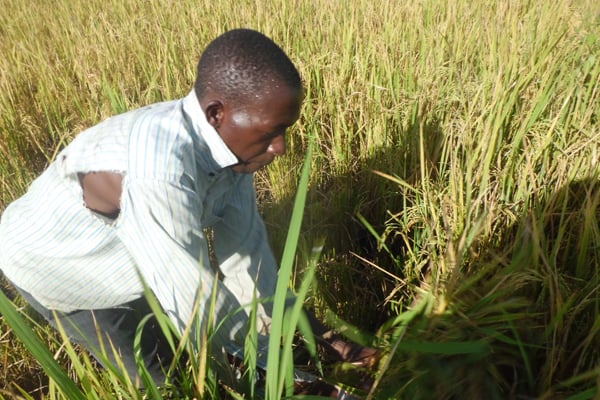Anther culture answer to rice breeding challenge

A farmer scouts for pests in his rice garden. Photo / Lominda Afedraru
What you need to know:
- The donor parents’ growing environment must be controlled for everything including light, nutrients, humidity, and temperature. It is also important to note that the developmental stage of the plant is very important upon selection.
Scientists across the globe including those in Uganda breeding rice are currently applying anther culture technology in breeding rice.
It is a technique by which the developing anthers at a precise and critical stage are removed aseptically from unopened flower bud and are cultured on a nutrient medium where the microspores within the cultured anther develop into corn tissue that gives rise to haploid.
Anther culture
Anther culture involves selecting suitable parents in a breeding programme depending on the goals and conducting across. Suitable parents are those that carry excellent agronomic traits of interest which can be cultured easily. Scientists usually use sources of immature pollen grains located within the anthers for crossings to be done. The donor parents’ growing environment must be controlled for everything including light, nutrients, humidity, and temperature. It is also important to note that the developmental stage of the plant is very important upon selection.
Steps taken in anther culture
In the following measures, Dr Jimmy Lamo explains how farmers can use anther culture to develop better rice varieties. The flowers or buds must be sterilised depending on the species and the media requirements may differ. After the flower is removed, it is kept on ice and the anthers are dissected via microscopy and sterilised forceps. The anthers are then transferred to solid nutrient rich media and a callus is formed. Breeders should try culturing before conducting large scale production as some genotypes within a species are better suited for haploid production than others.
Afterward, a callus is formed and transferred to another media to produce embryos where the haploid plant is generated.
After sufficient growth, the haploid plant is placed in soil or rooting media and then is subjected to artificial chromosome doubling.
Rice varieties
Dr Samson Ojok, working with the rice breeding programme at NaCRRI, explaining about the newly released varieties noted that there are more than 15 varieties which farmers are growing in upland and irrigated low lands. These include the Nerica series Nerica 1 – 10 and Namche 1-6 all grown upland. The irrigated lowland varieties are Wita9, Komboka, Agoro and Okile varieties. The yield rate of these varieties under good management are 2-3 tonnes per hectare.
Newly released varieties
The newly released varieties include Naro Rice 1 containing straw coloured grains and matures in 95 days. The yield rate is 5,708 kilogrammes per hectare.
Naro Rice 2 matures in 120 days and has slender grains similar to Basmat rice variety imported from Pakistan with yield rate of 5,980 kilogrammes per hectare.
Naro Rice 3 mature in 115 days and it has heavy grains bigger than the preferred Super rice and it yields 4,760 kilogrammes per hectare.
Naro Rice 4 matures in 130 days and yields 6,520 kilogrammes per hectare with heavy and bigger grains.
All these varieties are bred for purposes of substituting imported rice into the country and they are tolerant to Rice Mortal virus disease, Rice blight and bacterial leaf streak.




